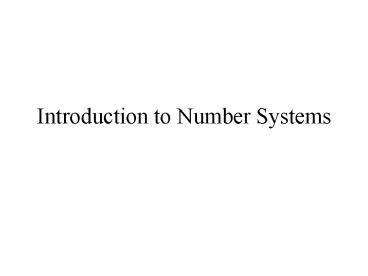Introduction to Number Systems - PowerPoint PPT Presentation
1 / 26
Title:
Introduction to Number Systems
Description:
Basic memory elements hold only two states. Zero / One. Thus a number system with two elements {0,1} ... MSB as in sign magnitude. Complement all the other bits ... – PowerPoint PPT presentation
Number of Views:655
Avg rating:5.0/5.0
Title: Introduction to Number Systems
1
Introduction to Number Systems
2
Storyline
- Different number systems
- Why use different ones?
- Binary / Octal / Hexadecimal
- Conversions
- Negative number representation
- Binary arithmetic
- Overflow / Underflow
3
Number Systems
- Four number system
- Decimal (10)
- Binary (2)
- Octal (8)
- Hexadecimal (16)
- ............
4
Binary numbers?
- Computers work only on two states
- On
- Off
- Basic memory elements hold only two states
- Zero / One
- Thus a number system with two elements 0,1
- A binary digit bit !
5
Decimal numbers
- 1439 1 x 103 4 x 102 3 x 101 9 x 100
- Thousands Hundreds Tens
Ones - Radix 10
6
Binary Decimal
- 1101 1 x 23 1 x 22 0 x 21 1 x 20
- 1 x 8 1 x 4 0 x 2 1 x
1 - 8 4 0 1
- (1101)2 (13)10
- 1, 2, 4, 8, 16, 32, 64, 128, 256, 512, .
7
Decimal Binary
13
2
LSB
1
6
2
0
3
2
1
1
2
1
MSB
0
(13)10 (1101)2
8
Octal Decimal
- 137 1 x 82 3 x 81 7 x 80
- 1 x 64 3 x 8 7 x 1
- 64 24 7
- (137)8 (95)10
- Digits used in Octal number system 0 to 7
9
Decimal Octal
95
8
LSP
7
11
8
3
1
8
1
0
MSP
(95)10 (137)8
10
Hex Decimal
- BAD 11 x 162 10 x 161 13 x 160
- 11 x 256 10 x 16 13 x 1
- 2816 160 13
- (BAD)16 (2989)10
- A 10, B 11, C 12, D 13, E 14, F 15
11
Decimal Hex
2989
16
LSP
13
186
16
10
11
16
11
0
MSP
(2989)10 (BAD)16
12
Why octal or hex?
- Ease of use and conversion
- Three bits make one octal digit
- 111 010 110 101
- 7 2 6 5 gt 7265 in
octal - Four bits make one hexadecimal digit
- 1110 1011 0101
- E B 5 gt EB5 in
hex
4 bits nibble
13
(No Transcript)
14
Negative numbers
- Three representations
- Signed magnitude
- 1s complement
- 2s complement
15
Sign magnitude
- Make MSB represent sign
- Positive 0
- Negative 1
- E.g. for a 3 bit set
- -2
16
1s complement
- MSB as in sign magnitude
- Complement all the other bits
- Given a positive number complement all bits to
get negative equivalent - E.g. for a 3 bit set
- -2
17
2s complement
- 1s complement plus one
- E.g. for a 3 bit set
- -2
18
No matter which scheme is used we get an even set
of numbers but we need one less (odd as we have
a unique zero)
19
Binary Arithmetic
- Addition / subtraction
- Unsigned
- Signed
- Using negative numbers
20
Unsigned Addition
- Like normal decimal addition
- B
- A
- The carry out of the MSB is neglected
0101 (5) 1001 (9) 1110 (14)
21
Unsigned Subtraction
- Like normal decimal subtraction
- B
- A
- A borrow (shown in red) from the MSB implies a
negative
1001 (9) - 0101 (5) 0100 (4)
22
Signed arithmetic
- Use a negative number representation scheme
- Reduces subtraction to addition
23
2s complement
- Negative numbers in 2s complement
- 001 ( 1)10
- 101 (-3)10
- 110 (-2)10
- The carry out of the MSB is lost
24
Overflow / Underflow
- Maximum value N bits can hold 2n 1
- When addition result is bigger than the biggest
number of bits can hold. - Overflow
- When addition result is smaller than the smallest
number the bits can hold. - Underflow
- Addition of a positive and a negative number
cannot give an overflow or underflow.
25
Overflow example
- 011 (3)10
- 011 (3)10
- 110 (6)10 ????
- 1s complement computer interprets it as 1 !!
- (6)10 (0110)2 requires four bits !
26
Underflow examples
- Twos complement addition
- 101 (-3)10
- 101 (-3)10
- Carry 1 010 (-6)10 ????
- The computer sees it as 2.
- (-6)10 (1010)2 again requires four bits !































